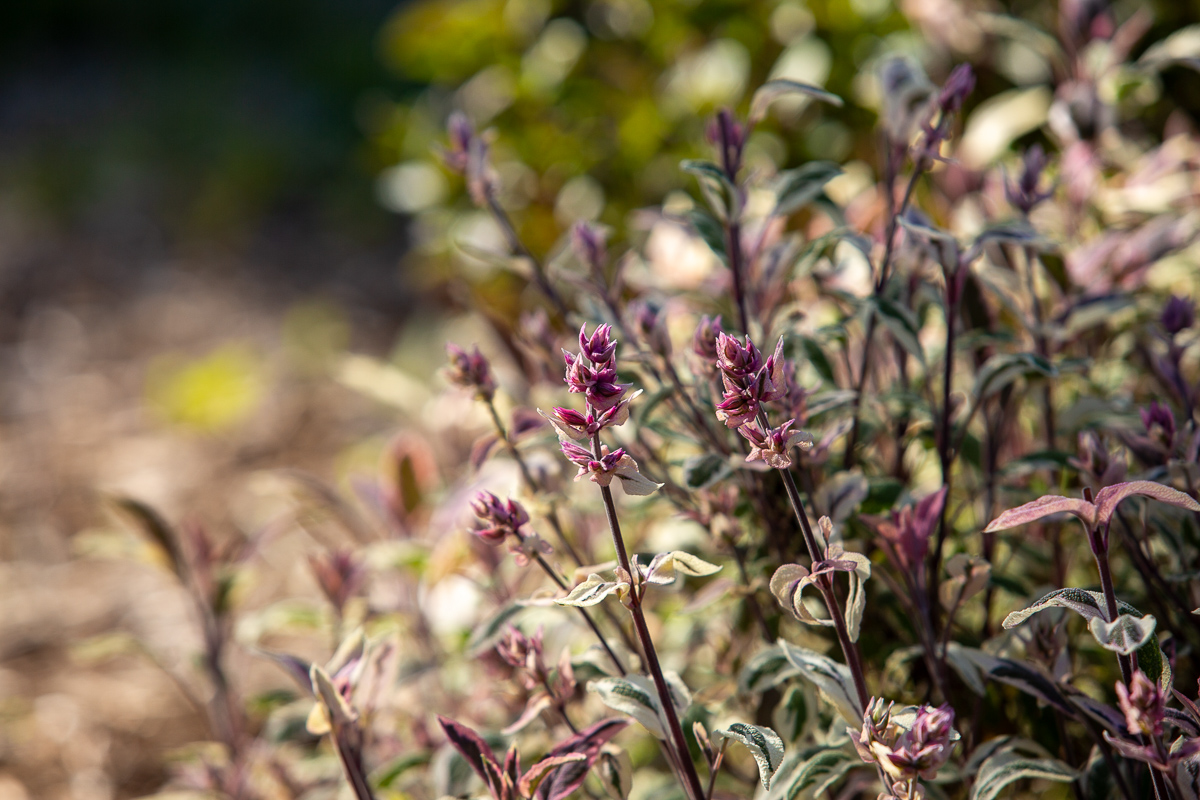Wise People Plant Sage
First published in the July 2024 edition of Grapevine, the newsletter for Yamhill County Master Gardeners.
The love affair with culinary sage began in a practical manner. This gardener had a vision to turn a sloped pasture of weeds into a habitat oasis. And the deer danced with joy. We quickly built a tall fortress around the vegetable garden, but what remains we share with the wildlife. My search for deer-resistant, edible and beautiful plants led straight to herbs.
Sage (Salvia) is the largest genus in the mint family, with over 900 species worldwide. Salvia officinalis varieties are herbaceous evergreens with gorgeous colorful leaves and texture. They are aroma-filled fuzzy delights. The complex shades include silver green, purple haze, candy-striped pink, and more.
As if the leaves weren’t enough to inspire adoration, common sage blooms bright in early summer. The bluish-lavender to pink-lavender petals are born in whorls on short, upright flower spikes. Each flower has two lips to kiss visiting bumble bees, butterflies and occasional hummingbirds.
I am ashamed to say that for years as the flowers began to emerge, I promptly snipped them. But when you know better you do better. Leaving sage flowers to bloom does not alter the flavor of the leaves or stress the plant. And the flowers themselves are edible and delicious. Sage blossoms also look and smell wonderful in bouquets or pressed for art projects.
If you want your sage to put 100 percent of its energy into producing leaves, then by all means snip the flowers. But you are missing out on quite a show.
Sage is hardy in zones 4-10 and likes well-drained soil. It propagates like a dream. Take softwood cuttings in early summer or root low branches into the ground. Untended sage plants will become woody after four or five years. Propagating new plants each year keeps the garden plentiful and attractive.
Sage leaves are ready to harvest most of the year. Salt and pan-fry fresh leaves in olive oil for a quick 30 seconds and you’ll have a gourmet garnish for soups and salads. Dried or fresh sage is a signature scent on many Thanksgiving tables.
Purpurea, Tricolor, Berggarten. Whichever garden sage you choose will have high amounts of vitamins A and C. The herb also contains some volatile oils. A compound of camphor, pinene, thujone, and others, as well as estrogenic substances and flavonoids mean a little sage goes a long way. An abundance of sage could make you sick.
“Cur moriatur homo cui salvia crescit in horto?
Why should a man die who has sage growing in his garden?”
This much-quoted Latin saying is from the famous medieval poem, Regimen Sanitatis Salernitanum, on maintaining good health. Sage was first cultivated by the 9th century European emperor Charlemagne and linked to longevity ever since. The name salvia comes from the Latin verb salvere or “to save.” The common name “sage” is a nod to the Old French word meaning wise.
Sage achieved notoriety in the famous tale of an essential oil and vinegar blend used by the “Four Thieves.” The 14th-century spice traders would rub the liquid on themselves then rob victims of the plague. The herbal concoction contained natural repellents to the flea that carried the plague bacillus.
“Take three pints of strong white wine vinegar, add a handful of each of wormwood, meadowsweet, wild marjoram and sage, fifty cloves, two ounces of campanula roots, two ounces of angelic, rosemary and horehound and three large measures of champhor. Place the mixture in a container for fifteen days, strain and express then bottle. Use by rubbing it on the hands, ears and temples from time to time when approaching a plague victim.”
vinegar recipe at the Museum of Paris in 1937
A few essential oils would not inspire such confidence in me against the plague. But it is encouraging that the powerful sage could help my tomatoes and eggplants. The herb is a deterrent for cabbage moths, beetles, carrot flies, and black flea beetles. My vegetable plants could use a break from flea beetles. A sprinkling of sage leaves in the garden beds and a homemade spray bottle of sage water is worth a try.
Another piece of sage advice is to avoid planting the herb near cucumbers or basil. Cucumbers absorb the strong sage flavors and basil’s watering needs are not compatible.
Native Americans used California white sage, Salvia apiana, as a cure-all. They also mixed it with animal fat to create a salve.
It would be remiss to not also mention sage and smudging, a sacred ceremony of most First Nations. Burning herbs like sage is said to offer protection from negative forces and to purify the body, mind, heart, and spirit.
Once in a desperate attempt to remedy the awful vibes and smell of my son’s newly acquired Eurovan, I tried burning common sage. I filled that beastly vessel with sage smoke. Once the overwhelming herb smell aired out, the interior of the van was transformed. Evidently sage is as good for chasing out the diabolic odor in a car as it is for warding off hungry deer in the garden.



